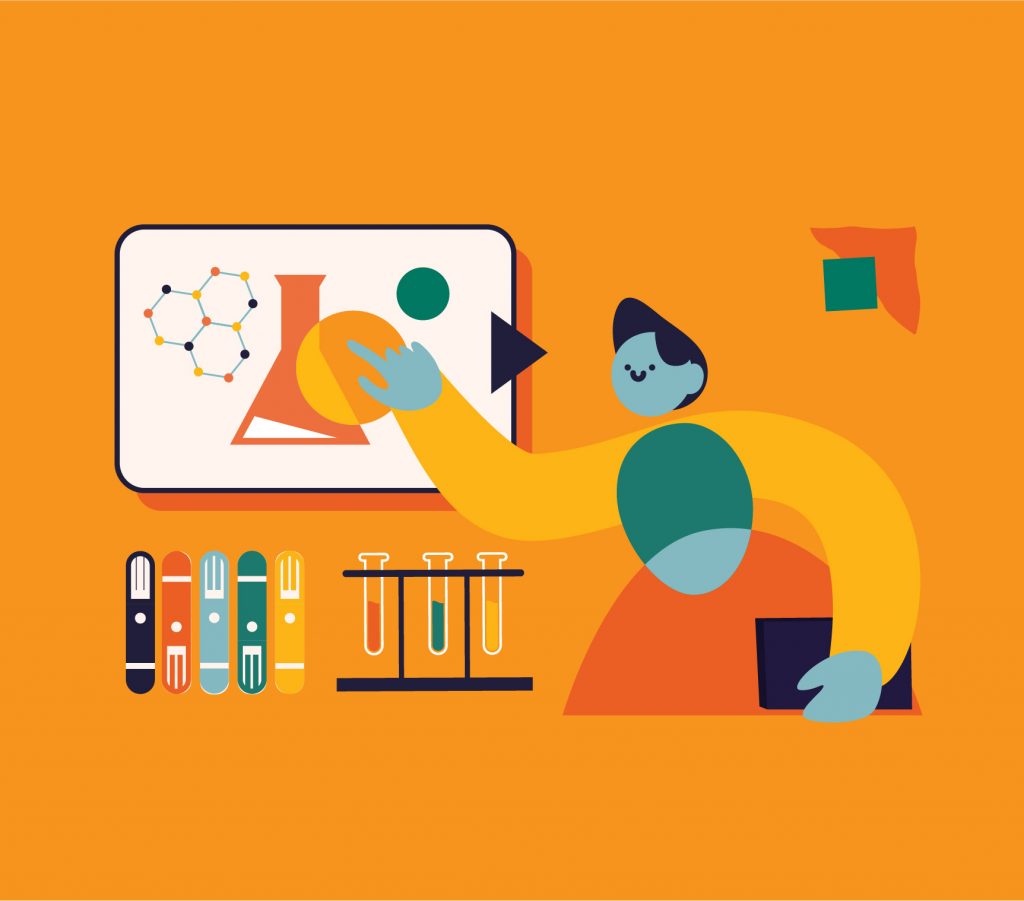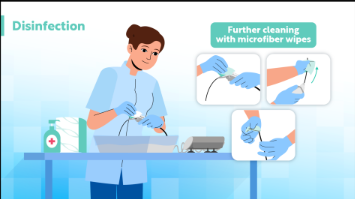Explaining medical devices can be difficult, right? But with animation videos, we can simplify the complex concepts of medical devices. Whether you’re a doctor or just curious about using medical devices, these videos help everyone get what they need to know. Below is our step-by-step guide on how to use 2D animation to explain medical devices. By following this guide, you are guaranteed to have a comprehensive checklist that will help you start creating a 2D medical device animation explaining medical devices, step by step, and with the help of a case study from F.Learning Studio when we worked with UV Smart as well!
Pre-production
In the initial stage of producing a medical device explainer video, analyzing needs and ensuring sufficient knowledge about the device are all crucial steps one must take.
1. Analyze needs
We start by analyzing the needs and the goal of the project. Firstly, we find out who the audience of the medical animation video is. The criteria used to sort the audience are age, occupation, nationality, geographic location, etc. so that we can figure out whether they are in the healthcare industry or not. Doing that helps us assess their prior knowledge about medical and healthcare, which in turn allows us to tailor the content appropriately and make the content more relevant to their needs and interests.

The next step is to identify the purpose of the video. Will the video be used for training purposes, or will it be used for educational purposes or even promotion, for example. This will help clarify the message that the client wants to transfer as well as help us tailor the video content to the specific needs and interests of the target audience.
After that, we will identify on which platform the medical device animation video will be uploaded. Will it be uploaded on social media platforms such as YouTube or TikTok, or will it be shown physically in hospitals or conferences, for example. This is an important step because different platforms have varying specifications for video format, resolution, and aspect ratio. Knowing the upload destination allows us to tailor the video’s technical aspects to meet the requirements of the specific platform.
Overall, analyzing needs help us prepare direction for the medical device animation video, the language we should use, the type of content we should make as well as the format and size of the video.
2. Ensure sufficient knowledge about the device
To explain to the audience about the medical device, one must understand the device first. What it means is we will study the its’ structure and how it is used, based on:
- Any video or written material about the device
- Research of the images and video of similar devices on the market to understand more about the device’s role, how it is used, and the biggest difference between the client’s device and similar devices.
In the process of ensuring knowledge, we will continuously double check and confirm all the information with our client to ensure that we understand the structure and the usage of the device the right way.
Production
1. Script writing
A script serves as the blueprint for visual production, providing a detailed plan for illustrators and animators to bring a story to life. Before writing a script, it’s essential to define the central theme and message you want to convey and develop characters (if needed). Successful script writing requires achieving the following criteria:
- Using the correct technical words. For example, the name of the different parts of the device.
- Using words appropriate to the audience (prior knowledge, occupation, age, nationality, geographic area, etc.). For example, if the viewers have prior knowledge about the medical device already, we will use short, concise and specialized words. However, if the viewers have limited knowledge about the device, we will use easy-to-understand words.
- Having a clear layout. For example, the script should have the introduction part, the body part and the conclusion part. It should also introduce the product and how the product will solve patients’ issues.
- Including relevant information about privacy and policy.

2. Storyboard and Illustration
Once the script is finalized, the next step is often creating a storyboard. This is where you visualize the texts in the script and turned them into pictures. A storyboard is a visual representation of how each scene in the animation unfolds. It outlines the sequence of shots, camera angles, and key visuals. For successful storyboarding and illustration, the visuals must meet the following requirements:
- Conceptualizing and designing styleframes: Based on script and direction, design some keyframes in the video, containing the image of the device to get the first view of the video. The client must approve the styleframes before moving on to the next step.
- Color: The main colors used in healthcare and medical are white, green and sky blue. However, do not forget to follow the colors in the client’s brand guideline for consistent brand image and clear brand recognition. Moreover, consider using light tone colors to create a safe and friendly feeling.
- Accuracy: You need to visualize correctly about the device. Show angles that help viewers see the device comprehensively first (front angle, ¾ angle, behind angle), then go into the description of each component and the process of using the device (depending on the script). Use elements such as labels and arrows to annotate the structure. Also, use a map or timeline to describe the overview process, then go into each section to interpret each step. This helps viewers have an overall view of the product first before going into details, which will help them absorb information better.

3. Animation
Once you have the sequence of scenes and key visuals from the storyboarding and illustration stage, you get to the animatic stage. This is the part where you turn your static images into life. To animate a medical device, at F.Learning Studio, we typically make sure that the following criteria are met:
- Accuracy: Ensuring the accuracy of the video when animating how the device works is vital. To achieve the utmost accuracy in representing the device, we frequently analyze authentic footage of the device, incorporating these insights into the animation video.
- Labeling and annotations: Labeling involves clearly marking different parts of the illustration, while annotations add extra information. For a medical device illustration, this means naming and explaining each component, ensuring that viewers easily understand what they are looking at.
- Video pace: Typically, we adopt a more deliberate pace for medical device animation videos, allocating an average of 3 to 4 seconds per scene. This allows viewers time to receive and process the information presented.
- Voice over: Integrating voiceover narration and audio elements into the animation elevates the engagement and understanding of the content. Make sure your voice in the video is distinctly clear, and ensure accurate pronunciation of specialized words.
- Background music: Use background music with a contemporary feel, featuring a lively atmosphere and a moderate volume. This ensures it complements rather than overpowers the voiceover, preventing distractions for the viewers.
Post-production
1. Quality control
Ensuring the quality and effectiveness of a medical device animation involves a comprehensive review and revision process. At F.Learning Studio, the output file at each step of the production process is sent to the client to check and confirm accuracy and ease of understanding of the video. The output file is then provided to the end user / audience for further feedback. After that, we address any areas that may need improvement. It’s crucial to ensure quality and scientific accuracy at every stage of creating a medical device animation. This helps guarantee that the final video maintains a high standard.
Case study
Now that you’ve explored our guide, let’s delve into a practical example featuring F.Learning Studio and UV Smart. This case study walks you through our process of creating a medical device animation for UV Smart’s new device, the D60, which is used to disinfect ENT probes. The case study will help you gain insights into real-world situations as well as demonstrating how the theories and principles in our guide above work in real-life contexts.
Recommended reading:
7 Best Scientific Animation Companies in 2024
1. Pre-production
Analyze clients’ needs
When working with UV Smart on this project, our approach involves dedicating sufficient time to thoroughly grasp their project briefs. We carefully reviewed their briefs and scheduled meetings to extract comprehensive information about the target audience, the video’s purpose, and the intended platform for its release. Understanding that UV Smart aims at healthcare professionals to explain their products, and considering the dual usage of the medical device video on their website and in conferences, we meticulously documented the essential criteria essential for crafting an animation video tailored to this specific audience.
For instance, recognizing that healthcare professionals require a lot of insights into the product’s benefits and usage, we made a concerted effort to incorporate details of how the product can be used. Additionally, for optimal adaptability, we took note of different specifications for the video on each platform, allowing us to make necessary adjustments post-animation completion if required.
Ensure sufficient knowledge about the device
Collaborating with UV Smart to create any medical device animation for their products involves ensuring that every member of our production team has a comprehensive understanding of the intricacies of the devices, ensuring the most accurate representation. To enhance our knowledge, we enlisted the support of an L&D team for in-depth research on devices and comparable products. Additionally, we prioritized regular communication with the client, dedicating sufficient time each week to discuss our evolving understanding of the devices and address any inquiries or feedback.

For instance, we aimed to grasp the step-by-step process of using the UV Smart D60 device thoroughly, ensuring accuracy in its portrayal within the video. Upon collaboration with their project manager, we obtained an real-life video illustrating the complete 7-step procedure of using the D60. This video was shared with both the Production and L&D teams for comprehensive analysis and planning, ensuring a solid understanding of every details of the device.
Continuous communication with UV Smart every time there was something we could not understand also allowed us to address any uncertainties and further enhanced our knowledge base. This robust foundation of knowledge significantly contributed to the accurate portrayal of the device in the final video and to the later stages of producing the medical device animation video.
2. Production
Script writing
For the UV Smart project targeted at healthcare professionals—individuals with a good understanding of healthcare knowledge and medical devices—we wrote our script with intricate terminologies needed for healthcare professionals to understand the device, but also included everyday language as well to ensure a comfortable viewing experience for them. Our video layout was meticulously designed for clarity, with the introduction segment presenting the device, the body portion elucidating its functionalities, and the conclusion featuring a quick note about the product, and a brief appearance of UV Smart’s logo.
Storyboard and illustration
To help you visualize how storyboards and illustrations can be done, take a look at the illustration below. The illustration we created closely replicates the details from the real-life video provided by UV Smart. Every element is depicted with precision, mirroring the accuracy seen in the real video. This guarantees that the medical device animation achieves a high level of realism, which makes it easy for the viewers to know what to do by just following the animation.

For the color palette, we employ UV Smart’s brand color mixed with white. As a result, the color palette instills a pleasant and friendly feeling without sacrificing UV Smart’s brand color. We also included annotations to the illustration. The annotations, stating ‘Further Cleaning with Microfiber Wipes,’ were incorporated to provide additional details not explicitly shown in the video. Additionally, three concise frames were inserted into the illustration, offering a clear visual representation of the proper execution of how the ‘further cleaning’ step needs to be done.
Kindly be aware that the finalization of this illustration version is contingent upon receiving approval from UV Smart. This ensures that the illustration aligns with the clients’ expectations and prevents any misalignment from affecting subsequent steps in the process.
Animation
Let us guide you through the animation steps using a video created for UV Smart. In the brief snippet below, we thoroughly research the device cleaning process and sticker placement to accurately animate these crucial steps. This precision ensures that viewers gain a clear understanding of the procedures to follow post-viewing.
The video maintains a deliberately slow pace. Both the ‘Regular Cleaning’ and ‘Sticker Placement’ steps are presented for a duration of at least 3-4 seconds on the screen, allowing ample time for viewers to absorb the information.
As for labelling, we use a 48-hour symbol to indicate that the validation of the cleaning process occurs every 48 hours.
The voiceover in the video is intentionally set at a slow pace as well. We directed the voice artist to maintain a reading speed of approximately or less than 150 words per minute, ensuring that viewers can easily follow along with the video. The background music, while lively, is carefully adjusted to a moderate volume to prevent overshadowing the voiceover, providing a balanced audio experience.
3. Post-production
Quality control
For UV Smart’s project, we prioritize a thorough review process for our animation videos, involving not just the Project Manager directly working with us but also individuals from various departments within the company. This approach is crucial because different departments contribute diverse perspectives and expertise, ensuring a comprehensive assessment of the medical animation video. At the same time, it helps mitigate potential risks associated with aspects like compliance, finance, or marketing, enhancing the overall quality and alignment of the deliverable.
V. Conclusion
In summary, creating a medical device animation video is a complex process requiring careful planning, creative execution, and continuous evaluation. Well-executed animations play a crucial role in effectively communicating information about medical devices. This guide promotes an ongoing commitment to evaluation and adaptation, acknowledging the changing educational needs in healthcare. As technology and communication advance, animation continues to be a powerful tool for explaining complex medical concepts to diverse audiences.
As an experienced medical animation company, F.Learning Studio is capable of producing captivating, yet scientifically accurate animation videos for healthcare organizations all around the world. Contact us now to get a quote and start your animation journey with us!



![Top 5 Healthcare Video Production Companies to Work With [Update 2025] 7 top healthcare video production company](https://flearningstudio.com/wp-content/uploads/2021/06/414x364-3-420x370.jpg)
